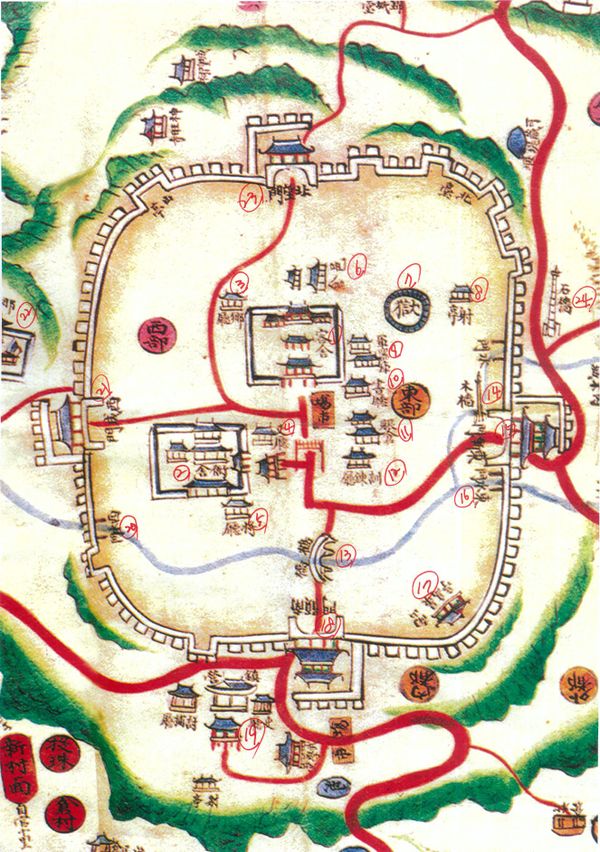읍성 내외 시설(나주목 관아와 향교)
HeritageWiki
| 읍성 내외 시설 Facilities of Najueupseong Walled Town |
|
해설문
국문
- 객사(客舍): 왕을 상징하는 지방 궁궐로, 중앙의 정청(政廳)을 중심으로 동·서쪽에 날개처럼 익헌(翼軒)을 지어 고관·사신의 숙소로 사용
- 아사(衙舍): 관아 건물로 수령의 집무 공간인 외아(동헌)와 관사인 내아(금학헌)로 구성
- 향청(鄕廳): 향촌을 교화(敎化)하고 수령을 보좌하는 자치적 기구
- 이청(吏廳): 수령을 도와 지방행정을 담당하는 향리의 집무처
- 장청(將廳): 범죄 수사 업무를 처리하는 지금의 경찰서
- 읍창(邑倉): 나주읍성 안에 위치한 사창(司倉)으로 관곡(官穀)을 보관하는 창고
- 옥(獄): 감옥
- 사정(射亭): 관리들이 활 쏘는 연습을 하는 곳으로 읍성 내에 동·서·남쪽 3곳에 설치
- 군기고(軍器庫): 군사들이 사용하는 무기와 깃발 등 물품을 보관하는 창고
- 서청(書廳): 각종 문서를 보관, 관리하는 창고
- 진창(賑倉): 백성을 위해 비상시를 대비하여 곡식을 보관하는 창고
- 훈련청(訓鍊廳): 무예를 연습하고 무관을 뽑는 시험장
- 학교(鶴橋): 성안을 관통해 흐르는 나주천에 설치한 유일한 다리
- 목장(木檣): 풍수지리상 배 형국인 나주의 순조로운 항해를 기원하는 뜻에서 성안에 세운 나무 돛대
- 동점문(東漸門): 나주읍성 동쪽 성문
- 동수문(東水門): 나주읍성을 관통하는 나주천 물길이 동쪽 성벽을 지날 수 있게 만든 수문
- 최고정(最高亭): 나주읍성 내에서 가장 높은 남산 정상부에 위치한 정자
- 남고문(南顧門): 나주읍성 남쪽 성문
- 전라우영(全羅右營): 1393년 나주의 군정(軍政)과 형정(刑政)을 지휘, 감독하고 병마(兵馬,육군)권을 관장하는 조직이 설치되었고, 이것이 1657년 전라우영으로 개편되면서 영장(정3품 무관)이 배치되어 관할지의 군정과 경찰 행정을 지휘, 감독 (지금의 나주초등학교 자리)
- 서수문(西水門): 나주읍성을 관통하는 나주천 물길이 서쪽 성벽을 지날 수 있게 만든 수문
- 서성문(西成門): 나주읍성 서쪽 성문
- 나주향교(鄕校): 조선시대 지방에 설치한 국립 교육기관으로 오늘의 중·고등학교
- 북망문(北望門): 나주읍성 북쪽 성문
- 석장(石檣): 풍수지리상 배 형국인 나주의 순조로운 항해를 기원하는 뜻에서 성밖에 세운 돌 돛대(보물)
영문
Facilities of Najueupseong Walled Town
- Guesthouse: A building consisting of a shrine in the center, where a wooden tablet symbolizing the king was kept to exhibit his sovereignty, and wings to either side, where visiting officials were temporarily accommodated
- Local Magistrate’s Quarters: These quarters consisted of the magistrate’s office and residence
- Local Elites’ Office: A self-governing organization that assisted the magistrate and edified the local area
- Clerks’ Office: The workplace of the local clerks who assisted the magistrate in local administration
- General’s Office: The office responsible for law enforcement and crime investigation
- Town Granary: A public granary used to store the grain collected as tax by the local government
- Prison: An incarceration facility for criminals
- Public Pavilion: A pavilion used by officials to practice archery; One each in the east, west, and south of the walled town
- Armory: A storage facility for keeping items used by the military, such as weaponry and flags
- Archive: A storage facility for storing and maintaining various documents
- Relief Granary: A storage facility for storing grain reserved for public use in case of an emergency
- Training Office: A facility for practicing martial arts and an examination venue for selecting military officials
- Hakgyo Bridge: The only bridge across Najucheon Stream inside the walled town
- Wooden Mast: A wooden post erected inside the walled town to wish for Naju’s “smooth sailing,” as the local topography resembles a boat according to the Korean feng shui principles
- Dongjeommun Gate: The eastern gate of the walled town
- Eastern Watergate: The eastern outlet of Najucheon Stream
- Choegojeong Pavilion: A pavilion located atop the highest spot within the walled town
- Namgomun Gate: The southern gate of the walled town
- Army Headquarters of West Jeolla-do Province: The headquarters directed and supervised the local military and penal administration; First established as an army garrison consisting of infantry and cavalry in 1393 and reformed into the Army Headquarters of West Jeolla-do Province in 1657 under the command of a third-rank military official (Located at the site of today’s Naju Elementary School)
- Western Watergate: The western outlet of Najucheon Stream
- Seoseongmun Gate: The western gate of the walled town
- Najuhyanggyo Local Confucian School: A public education institution established to promote the veneration of Confucian sages and the Confucian education of local elites.
- Bungmangmun Gate: The northern gate of the walled town
- Stone Mast: A stone post erected outside the walled town to wish for Naju’s “smooth sailing,” as the local topography resembles a boat according to the Korean feng shui principles (Designated as a Treasure)
